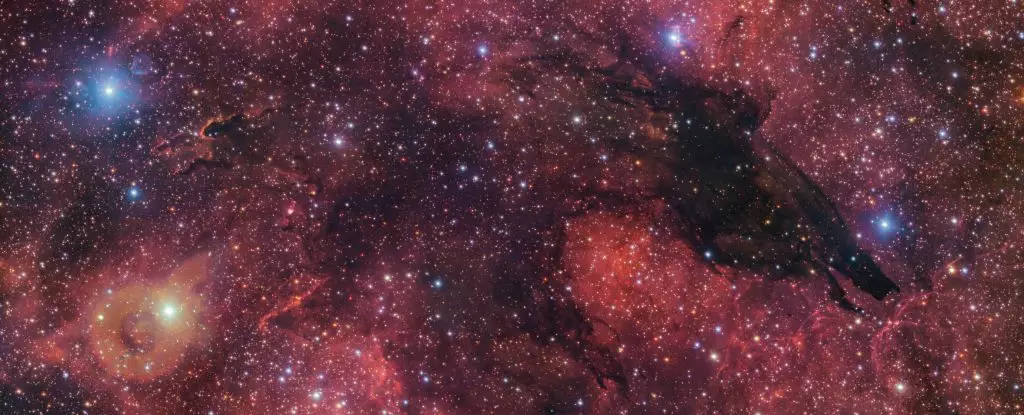In Norse mythology, Ragnarök signifies an apocalyptic event where Sköll, a monstrous celestial wolf, ultimately captures and consumes the Sun. This captivating tale highlights the interplay between chaos and creation, a theme resonant across various cultures. Analogously, a real cosmic “wolf,” the Dark Wolf Nebula, presents a contrasting scenario in which creation triumphs over obliteration. Located about 5,300 light-years from Earth, the Dark Wolf Nebula stands as a testament to the complexities of astronomical phenomena and challenges our perceptions of the universe.
At first glance, the Dark Wolf Nebula appears as an enigmatic dark void, seemingly devoid of life and activity. However, rather than representing the end of stars, this nebula teems with potential as it is a cradle for new stellar formations. Part of a greater celestial entity known as Gum 55 in the southern constellation Scorpius, this nebula is a dark cloud in a larger region characterized by bright, glowing nebulosity.
This notion challenges our preconceived notions of cosmic structures. Dark nebulae, including the Dark Wolf, do not emit or reflect visible light, creating the illusion of a void. Yet, they are vibrant areas rich with the potential for stellar birth. The dust and gas found within these clouds are not merely remnants of dead stars; rather, they are the early building blocks of new stellar formations, waiting to undergo a transformative process.
Delving deeper into the mechanics of this process reveals a fascinating chain of events. The dense, cold clouds of dust and gas in the Dark Wolf Nebula play a crucial role by emitting infrared light, which allows them to dissipate thermal energy. Once a certain degree of cooling is achieved, gravity becomes the dominant force, pulling together clumps of material within the cloud. This gravitational attraction leads to the formation of dense patches of gas and dust—the early seeds of stars.
As these nascent stars accumulate mass, they build up enough energy to initiate nuclear fusion at their cores. This stage marks the transition from a mere accumulation of material to the birth of a new star. This natural progression reflects how chaos within these dark clouds ultimately gives birth to luminous celestial bodies, illuminating the night sky in the future.
Despite their importance, the very characteristics that make dark nebulae fascinating also render them difficult to study. The dense clouds obscure visible light, creating challenges for astronomers attempting to observe the internal dynamics of star formation. Nevertheless, advancements in infrared astronomy have made this task more feasible. Instruments such as the James Webb Space Telescope (JWST) can detect infrared wavelengths that penetrate the dust clouds, revealing the star-forming processes hidden from traditional optical observations.
Moreover, complementary observations across the spectrum are necessary for a thorough understanding of these regions. Visible-light images, such as those captured by the VLT Survey Telescope, provide context about surrounding structures and environmental conditions, enhancing our comprehension of where stars originate.
The dual role of celestial entities evokes a reflection on the cycle of life in the universe. While Sköll, the mythological wolf, signifies destruction in the form of the Sun’s demise, the Dark Wolf Nebula represents the genesis of new stars. This juxtaposition between creation and destruction invites a philosophical inquiry into the nature of cosmic life. As a new generation of stars emerges, they will eventually contribute to the cycle of stellar evolution by influencing the composition of their surrounding material through radiation and stellar winds.
The Dark Wolf Nebula is not just a cosmic anomaly; it is a vital source of knowledge about the birth of stars and the dynamic processes that govern our universe. As we continue to peer into the depths of these dark regions, we unravel more of the intricate tapestry of cosmic existence. The interplay of creation and destruction within the cosmos mirrors our own struggles and triumphs, offering profound insights into our understanding of the universe.


Leave a Reply